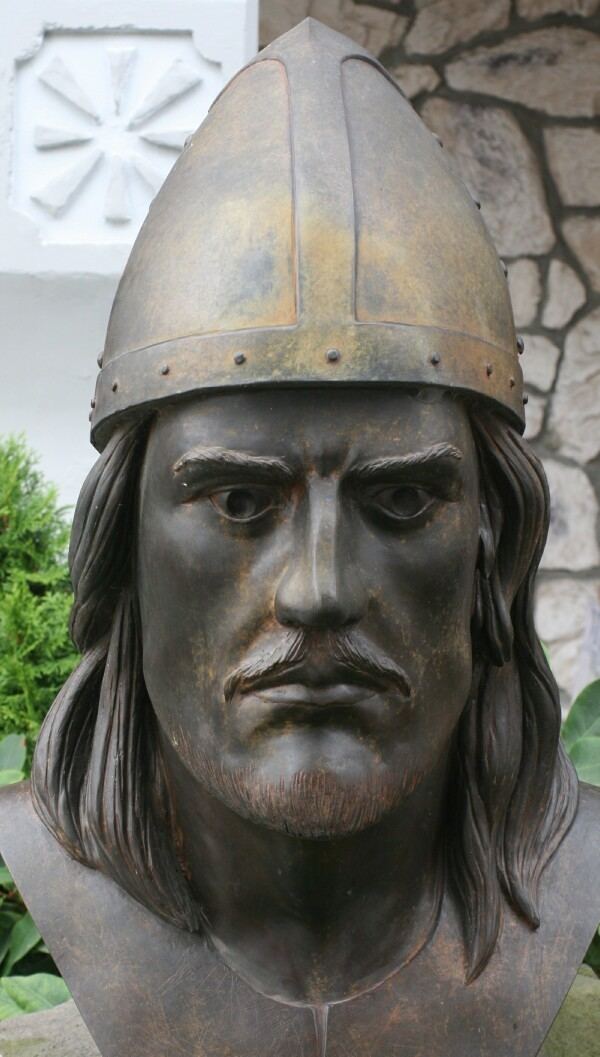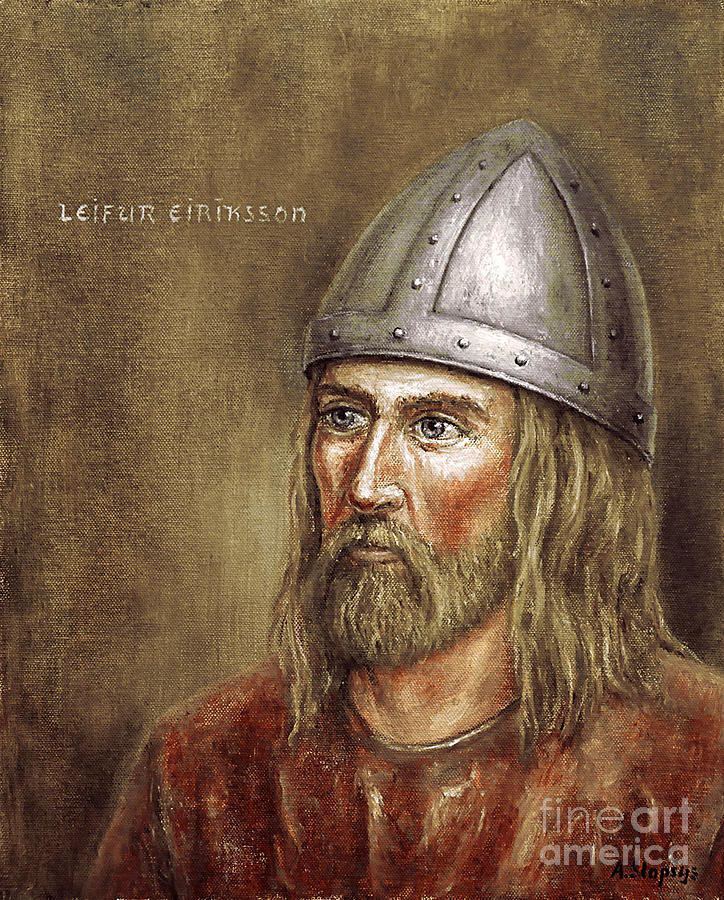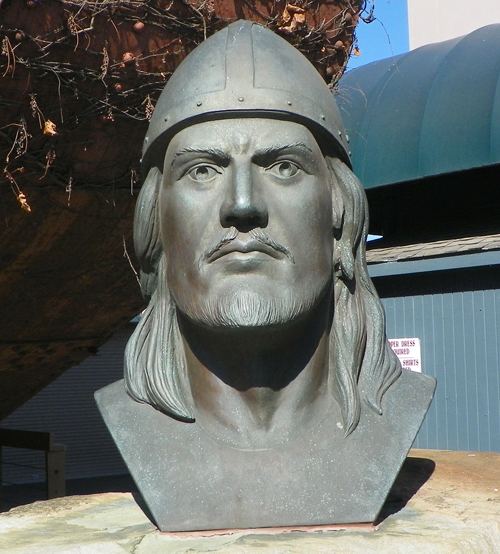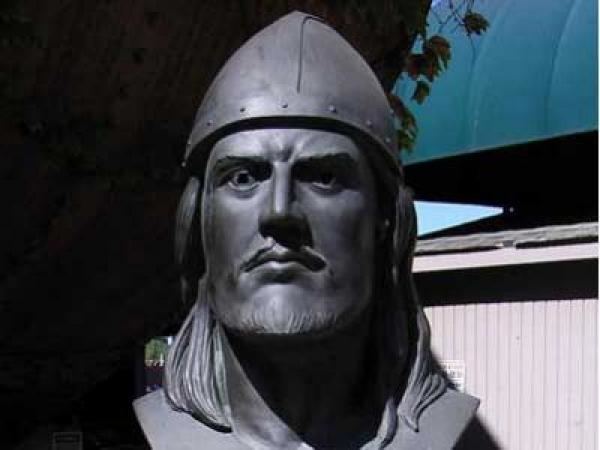Occupation Explorer Parents Erik the Red, Thjodhild Died 1020 | Name Leif Erikson Partner(s) Thorgunna (c. 999) Nationality Icelandic, Norwegian | |
 | ||
Siblings Freydis Eiriksdottir, Thorvald Eiriksson, Thorstein Eiriksson Children Thorkell Leif, Thorgils Leif Similar People Erik the Red, Leif Erickson, Freydis Eiriksdottir, Christopher Columbus, Thorvald Eiriksson | ||
Leif erikson looking for signs
Leif Erikson or Leif Ericson (Old Norse: Leifr Eiríksson; Icelandic: Leifur Eiríksson; Norwegian: Leiv Eiriksson c. 970 – c. 1020) was a Norse explorer from Iceland. He was the first known European to have discovered continental North America (excluding Greenland), before Christopher Columbus (or possibly Saint Brendan). According to the Sagas of Icelanders, he established a Norse settlement at Vinland, tentatively identified with the Norse L'Anse aux Meadows on the northern tip of Newfoundland in modern-day Canada. Later archaeological evidence suggests that Vinland may have been the areas around the Gulf of St. Lawrence and that the L'Anse aux Meadows site was a ship repair station.
Contents
- Leif erikson looking for signs
- Leif erikson young explorer award 2016 tashi nungshi malik
- Early life
- Discovering Vinland
- Personal life
- Norse and Medieval Europe
- Travels and Commoration
- References

Leif was the son of Erik the Red, the founder of the first Norse settlement in Greenland and of Thjodhild (Þjóðhildur), both of Norwegian origin. His place of birth is not certainly known, but he is assumed to have been born in Iceland, which had recently been colonized by Norsemen mainly from Norway. He grew up in the family estate Brattahlíð in the Eastern Settlement in Greenland. Leif had two known sons: Thorgils, born to noblewoman Thorgunna in the Hebrides; and Thorkell, who succeeded him as chieftain of the Greenland settlement.

Leif erikson young explorer award 2016 tashi nungshi malik
Early life

Leif was the son of Erik the Red and his wife Thjodhild, and the grandson of Thorvaldr Ásvaldsson, and distant relative of Naddodd, who discovered Iceland. He was a Viking in the early days. His year of birth is most often given as c. 970 or c. 980. Though Leif's birthplace is not accounted for in the sagas, it is likely he was born in Iceland, where his parents met—probably somewhere on the edge of Breiðafjörður, and possibly at the farm Haukadal where Thjóðhild's family is said to have been based. Leif had two brothers, whose names were Thorsteinn and Thorvaldr, and a sister, Freydís.

Thorvald Asvaldsson was banished from Norway for manslaughter and went into exile in Iceland accompanied by young Erik. When Erik was himself banished from Iceland, he travelled further west to an area he named Greenland, where he established the first permanent settlement in 986. Tyrker, one of Erik's thralls, had been specially trusted to keep in charge of Erik's children, as Leif later referred to him as his "foster father".
Discovering Vinland

Leif and his crew travelled from Greenland to Norway in 999 AD. Blown off course to the Hebrides and staying for much of the summer, he arrived in Norway and became a hirdman of King Olaf Tryggvason. He also converted to Christianity and was given the mission of introducing the religion to Greenland. The Saga of Erik the Red and the Saga of the Greenlanders, both thought to have been written around 1200, contain different accounts of the voyages to Vinland. The only two known strictly historical mentions of Vinland are found in the work of Adam of Bremen c. 1075 and in the Book of Icelanders compiled c. 1122 by Ari the Wise. According to the Saga of Erik the Red, Leif apparently saw Vinland for the first time after being blown off course on his way to introduce Christianity to Greenland.

According to a literal interpretation of Einar Haugen's translation of the two sagas in the book Voyages to Vinland, Leif was not the first European to discover America: he had heard the story of merchant Bjarni Herjólfsson who claimed to have sighted land to the west of Greenland after having been blown off course. Bjarni reportedly never made landfall there, however. Later, when travelling from Norway to Greenland, Leif was also blown off course, to a land that he did not expect to see, where he found "self-sown wheat fields and grapevines". He next rescued two men who were shipwrecked in this country and went back to Greenland (and Christianised the people there). Consequently, if this is to be trusted, Bjarni Herjólfsson was the first European to see America beyond Greenland, and the two unnamed shipwrecked men were the first people known to Europeans to have made landfall there.
Leif then approached Bjarni, purchased his ship, gathered a crew of thirty-five men, and mounted an expedition towards the land Bjarni had described. His father Erik was set to join him but dropped out after he fell from his horse on his way to set sail, an incident he interpreted as a bad omen. Leif followed Bjarni's route in reverse and landed first in a rocky and desolate place he named Helluland (Flat-Rock Land; possibly Baffin Island). After venturing further by sea, he landed the second time in a forested place he named Markland (Forest Land; possibly Labrador). Finally, after two more days at sea, he landed in a verdant area with a mild climate and plentiful supplies of salmon. As winter approached, he decided to encamp there and broke his party into two groups - one to remain at camp and the other to explore the country. During one of these explorations, Tyrker discovered that the land was full of vines and grapes. Leif therefore named the land Vinland. There, he and his crew built a small settlement, which was called Leifsbudir (Leif's Booths) by later visitors from Greenland. After having wintered over in Vinland, Leif returned to Greenland in the spring with a cargo of grapes and timber. On the return voyage, he rescued an Icelandic castaway and his crew, earning him the nickname "Leif the Lucky".
Research done in the early 1960s by Norwegian explorer Helge Ingstad and his wife, archaeologist Anne Stine Ingstad, identified a Norse settlement located at the northern tip of Newfoundland. It has been suggested that this site, known as L'Anse aux Meadows, is Leif's settlement of Leifsbúðir. The Ingstads demonstrated that Norsemen had reached America about 500 years before Christopher Columbus. Later archaeological evidence suggests that Vinland may have been the areas around the Gulf of St. Lawrence and that the L'Anse aux Meadows site was a ship repair station and waypoint for voyages there. That does not necessarily contradict the identification of L'Anse aux Meadows with Leifsbúðir since the two sagas appear to describe Vinland as a wider region which included several settlements. The Saga of Erik the Red mentions two other settlements in Vinland: a settlement called Straumfjǫrðr, which lay beyond Kjalarnes promontory and the Wonderstrands, and one called Hóp, which was located even farther south.
Personal life
Leif was described as a wise, considerate, and strong man of striking appearance. During his stay in the Hebrides, he fell in love with a noblewoman, Thorgunna, who gave birth to their son Thorgils. Thorgils was later sent to Leif in Greenland, but he did not become popular.
After Leif's first trip to Vinland, he returned to the family estate of Brattahlíð in Greenland, and started preaching Christianity to the Greenlanders. His father Erik reacted coldly to the suggestion that he should abandon his religion, while his mother Thjóðhildr quickly became a Christian and built a church called Thjóðhild's Church. Leif is last mentioned alive in 1019, and by 1025 he had passed on his chieftaincy of Eiríksfjǫrðr to another son, Thorkell. Nothing is mentioned about his death in the sagas—he probably died in Greenland some time between these dates. Nothing further is known about his family beyond the succession of Thorkell as chieftain.
Norse and Medieval Europe
Leif's successful expedition in Vinland encouraged other Norsemen to also make the journey. The first apparent contact between the Norse and the indigenous people, who the Norse later referred to as skrælingjar, was made by his brother Thorvald, and resulted in hostilities and killing. In the end there were no permanent Norse settlements in Vinland, although sporadic voyages at least to Markland for forages, timber and trade possibly lasted for centuries. The casual tone of references to these areas may suggest that their discovery was not seen as particularly significant by contemporaries, or that it was assumed to be public knowledge, or both. Knowledge of the Vinland journeys might have spread around medieval Europe, as writers such as Adam of Bremen made mention of remote lands to the west. It has been suggested that the knowledge of Vinland might have been maintained in European seaports in the 15th century, and that Christopher Columbus, who claimed in a letter to have visited Iceland in 1477, could have heard stories of it.
Travels and Commoration
Stories of Leif's journey to North America had a profound effect on the identity and self-perception of later Nordic Americans and Nordic immigrants to the United States. The first statue of Leif (by Anne Whitney) was erected in Boston in 1887 at the instigation of Eben Norton Horsford, who was among those who believed that Vinland could have been located on the Charles River or Cape Cod; not long after, another casting of Whitney's statue was erected in Milwaukee. A statue was also erected in Chicago in 1901, having been originally commissioned for the 1893 World's Columbian Exposition to coincide with the arrival of the reconstructed Viking ship from Bergen, Norway. Another work of art made for the 1893 World's Columbian Exposition, the painting Leiv Eiriksson oppdager Amerika by Christian Krohg, was in the possession of a Leif Erikson Memorial Association in Chicago before being given back to the National Gallery of Norway in 1900.
For the centenary of the first official immigration of Norwegians to America, President Calvin Coolidge stated at the 1925 Minnesota State Fair, to a crowd of 100,000 people, that Leif had indeed been the first European to discover America. Further statues of him were erected at the Minnesota State Capitol in St. Paul in 1949, near Lake Superior in Duluth in 1956, and in downtown Seattle.
The Sagas do not give the exact date of Leif Erikson's landfall in America, they only state that it was in the fall of the year. At the suggestion of Christian A. Hoen, Edgerton, Wis., 9 October was settled upon, inasmuch as that already was a historic date in the annals of Norwegians in America, the ship "Restaurationen" coming from Stavanger, arrived in New York Harbor on 9 October 1825 with its first organized party of Norwegian immigrants.
In 1929, the Wisconsin Legislature passed a bill to make 9 October "Leif Erikson Day" in the state; the bill was signed by Governor Walter J. Kohler, Sr. in May of the same year. In 1964 the United States Congress authorized and requested the president to proclaim 9 October of each year as "Leif Erikson Day".
